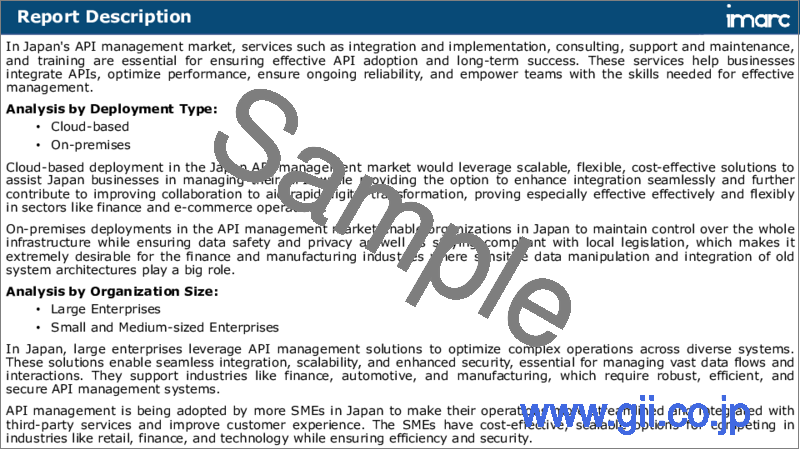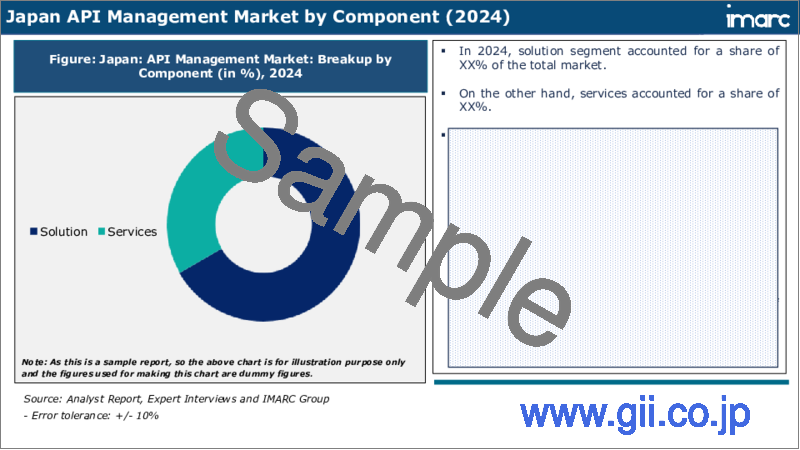|
|
市場調査レポート
商品コード
1609718
日本のAPI管理市場レポート:コンポーネント、展開タイプ、組織規模、業界別、地域別、2025年~2033年Japan API Management Market Report by Component, Deployment Type, Organization Size, Industry Vertical, and Region 2025-2033 |
||||||
カスタマイズ可能
|
|||||||
| 日本のAPI管理市場レポート:コンポーネント、展開タイプ、組織規模、業界別、地域別、2025年~2033年 |
|
出版日: 2024年12月05日
発行: IMARC
ページ情報: 英文 115 Pages
納期: 5~7営業日
|
全表示
- 概要
- 目次
日本のAPI管理市場の市場規模は2024年に8億1,970万米ドルに達しました。今後、IMARC Groupは、同市場が2033年までに37億1,080万米ドルに達し、2025年から2033年にかけて16.3%の成長率(CAGR)を示すと予測しています。データ保護に関連する厳しい規制の導入の増加、アプリケーションのクラウドへの移行の増加、業務の自動化と企業の生産性向上を目的としたモノのインターネット(IoT)の普及の増加が、市場を牽引する主な要因の1つとなっています。
本レポートで扱う主な質問
- 日本のAPI管理市場はこれまでどのように推移し、今後どのように推移するのか?
- COVID-19が日本のAPI管理市場に与えた影響は?
- 日本のAPI管理市場のコンポーネント別の内訳は?
- 日本のAPI管理市場の展開タイプ別の内訳は?
- 日本のAPI管理市場の組織規模別の内訳は?
- 日本のAPI管理市場の業界別の内訳は?
- 日本のAPI管理市場のバリューチェーンにはどのような段階がありますか?
- 日本のAPI管理における主な促進要因と課題は何か?
- 日本のAPI管理市場の構造と主要プレーヤーは?
- 日本のAPI管理市場における競合の程度は?
目次
第1章 序文
第2章 調査範囲と調査手法
- 調査の目的
- ステークホルダー
- データソース
- 市場推定
- 調査手法
第3章 エグゼクティブサマリー
第4章 日本のAPI管理市場:イントロダクション
- 概要
- 市場力学
- 業界動向
- 競合情報
第5章 日本のAPI管理市場情勢
- 過去および現在の市場動向(2019年~2024年)
- 市場予測(2025-2033)
第6章 日本のAPI管理市場:コンポーネント別の内訳
- ソリューション
- サービス
第7章 日本のAPI管理市場:展開タイプ別の内訳
- クラウドベース
- オンプレミス
第8章 日本のAPI管理市場:組織規模別の内訳
- 大企業
- 中小企業
第9章 日本のAPI管理市場:業界別の内訳
- BFSI
- ITおよび通信
- 小売・消費財
- 旅行と交通
- 政府
- メディアとエンターテイメント
- ヘルスケアとライフサイエンス
- 製造
- その他
第10章 日本のAPI管理市場:競合情勢
- 概要
- 市場構造
- 市場プレーヤーのポジショニング
- 主要成功戦略
- 競合ダッシュボード
- 企業評価象限
第11章 主要企業のプロファイル
第12章 日本のAPI管理市場:業界分析
- 促進要因・抑制要因・機会
- ポーターのファイブフォース分析
- バリューチェーン分析
第13章 付録
Japan API management market size reached USD 819.7 Million in 2024. Looking forward, IMARC Group expects the market to reach USD 3,710.8 Million by 2033, exhibiting a growth rate (CAGR) of 16.3% during 2025-2033. The growing implementation of stringent regulations associated with data protection, rising migration of applications to the cloud, and increasing proliferation of internet of things (IoT) to automate operations and enhance the productivity of businesses represent some of the key factors driving the market.
Application programming interface (API) management refers to the set of processes, tools, and policies that govern and secure the use of APIs in an organization. It comprises on-premises API management, which is deployed in the infrastructure of an organization, providing complete control over the API environment but requiring maintenance and resource allocation. It also consists of cloud-based API management, which is hosted on cloud platforms, offering scalability, flexibility, and reduced infrastructure overhead. It serves as a single entry point for managing and controlling access to APIs and handling tasks, such as authentication, authorization, and traffic management. It also ensures the confidentiality and integrity of data transmitted through APIs by implementing measures like encryption, token-based authentication, and access controls. It provides a user-friendly interface for developers to discover, understand, and test APIs. It often includes documentation, code samples, and other resources. It also monitors API usage in real-time, collects performance data, and generates analytics to help organizations make informed decisions and optimize API performance. It manages the onboarding, access, and permissions of developers using the APIs, ensuring compliance with policies and security measures. It governs the entire lifecycle of an API, from design and creation to retirement, ensuring that APIs are continuously updated and aligned with business objectives.
Japan API Management Market Trends:
At present, the increasing demand for efficient API management as it facilitates seamless integration between disparate systems, enabling them to exchange data and functionality, represents one of the crucial factors impelling the growth of the market in Japan. Besides this, the rising employment of API management, as it provides centralized control over the APIs, allowing organizations to monitor, manage, and secure their API ecosystems, is contributing to the market growth. In addition, organizations are increasingly gravitating towards decomposing monolithic applications into smaller, independent services, each encapsulated within its own microservice, enabling efficient communication and collaboration among them. Apart from this, the rising proliferation of cyber threats and the increasing value of data as a strategic asset are encouraging organizations to prioritize the implementation of robust security measures for their APIs. Additionally, the rising migration of applications and data to the cloud is driving the demand for efficient API management, as it enables seamless integration and communication between on-premises and cloud-based systems. Cloud-native API management solutions are also gaining traction, offering the flexibility and scalability needed to navigate the intricacies of multi-cloud environments. Moreover, the increasing proliferation of internet of things (IoT) to automate operations and enhance the productivity of businesses is supporting the market growth in the country. Furthermore, the rising implementation of stringent regulations associated with data protection is bolstering the market growth.
Japan API Management Market Segmentation: -
Component Insights:
- Solution
- API Platform
- API Analytics
- API Security
- Services
- Integration and Implementation
- Consulting
- Support and Maintenance
- Training and Education
Deployment Type Insights:
- Cloud-based
- On-premises
Organization Size Insights:
- Large Enterprises
- Small and Medium-sized Enterprises
Industry Vertical Insights:
- BFSI
- IT and Telecom
- Retail and Consumer Goods
- Travel and Transportation
- Government
- Media and Entertainment
- Healthcare and Life Sciences
- Manufacturing
- Others
Competitive Landscape:
The market research report has also provided a comprehensive analysis of the competitive landscape in the market. Competitive analysis such as market structure, key player positioning, top winning strategies, competitive dashboard, and company evaluation quadrant has been covered in the report. Also, detailed profiles of all major companies have been provided.
Key Questions Answered in This Report:
- How has the Japan API management market performed so far and how will it perform in the coming years?
- What has been the impact of COVID-19 on the Japan API management market?
- What is the breakup of the Japan API management market on the basis of component?
- What is the breakup of the Japan API management market on the basis of deployment type?
- What is the breakup of the Japan API management market on the basis of organization size?
- What is the breakup of the Japan API management market on the basis of industry vertical?
- What are the various stages in the value chain of the Japan API management market?
- What are the key driving factors and challenges in the Japan API management?
- What is the structure of the Japan API management market and who are the key players?
- What is the degree of competition in the Japan API management market?
Table of Contents
1 Preface
2 Scope and Methodology
- 2.1 Objectives of the Study
- 2.2 Stakeholders
- 2.3 Data Sources
- 2.3.1 Primary Sources
- 2.3.2 Secondary Sources
- 2.4 Market Estimation
- 2.4.1 Bottom-Up Approach
- 2.4.2 Top-Down Approach
- 2.5 Forecasting Methodology
3 Executive Summary
4 Japan API Management Market - Introduction
- 4.1 Overview
- 4.2 Market Dynamics
- 4.3 Industry Trends
- 4.4 Competitive Intelligence
5 Japan API Management Market Landscape
- 5.1 Historical and Current Market Trends (2019-2024)
- 5.2 Market Forecast (2025-2033)
6 Japan API Management Market - Breakup by Component
- 6.1 Solution
- 6.1.1 Overview
- 6.1.2 Historical and Current Market Trends (2019-2024)
- 6.1.3 Market Segmentation
- 6.1.3.1 API Platform
- 6.1.3.2 API Analytics
- 6.1.3.3 API Security
- 6.1.4 Market Forecast (2025-2033)
- 6.2 Services
- 6.2.1 Overview
- 6.2.2 Historical and Current Market Trends (2019-2024)
- 6.2.3 Market Segmentation
- 6.2.3.1 Integration and Implementation
- 6.2.3.2 Consulting
- 6.2.3.3 Support and Maintenance
- 6.2.3.4 Training and Education
- 6.2.4 Market Forecast (2025-2033)
7 Japan API Management Market - Breakup by Deployment Type
- 7.1 Cloud-based
- 7.1.1 Overview
- 7.1.2 Historical and Current Market Trends (2019-2024)
- 7.1.3 Market Forecast (2025-2033)
- 7.2 On-premises
- 7.2.1 Overview
- 7.2.2 Historical and Current Market Trends (2019-2024)
- 7.2.3 Market Forecast (2025-2033)
8 Japan API Management Market - Breakup by Organization Size
- 8.1 Large Enterprises
- 8.1.1 Overview
- 8.1.2 Historical and Current Market Trends (2019-2024)
- 8.1.3 Market Forecast (2025-2033)
- 8.2 Small and Medium-sized Enterprises
- 8.2.1 Overview
- 8.2.2 Historical and Current Market Trends (2019-2024)
- 8.2.3 Market Forecast (2025-2033)
9 Japan API Management Market - Breakup by Industry Vertical
- 9.1 BFSI
- 9.1.1 Overview
- 9.1.2 Historical and Current Market Trends (2019-2024)
- 9.1.3 Market Forecast (2025-2033)
- 9.2 IT and Telecom
- 9.2.1 Overview
- 9.2.2 Historical and Current Market Trends (2019-2024)
- 9.2.3 Market Forecast (2025-2033)
- 9.3 Retail and Consumer Goods
- 9.3.1 Overview
- 9.3.2 Historical and Current Market Trends (2019-2024)
- 9.3.3 Market Forecast (2025-2033)
- 9.4 Travel and Transportation
- 9.4.1 Overview
- 9.4.2 Historical and Current Market Trends (2019-2024)
- 9.4.3 Market Forecast (2025-2033)
- 9.5 Government
- 9.5.1 Overview
- 9.5.2 Historical and Current Market Trends (2019-2024)
- 9.5.3 Market Forecast (2025-2033)
- 9.6 Media and Entertainment
- 9.6.1 Overview
- 9.6.2 Historical and Current Market Trends (2019-2024)
- 9.6.3 Market Forecast (2025-2033)
- 9.7 Healthcare and Life Sciences
- 9.7.1 Overview
- 9.7.2 Historical and Current Market Trends (2019-2024)
- 9.7.3 Market Forecast (2025-2033)
- 9.8 Manufacturing
- 9.8.1 Overview
- 9.8.2 Historical and Current Market Trends (2019-2024)
- 9.8.3 Market Forecast (2025-2033)
- 9.9 Others
- 9.9.1 Historical and Current Market Trends (2019-2024)
- 9.9.2 Market Forecast (2025-2033)
10 Japan API Management Market - Competitive Landscape
- 10.1 Overview
- 10.2 Market Structure
- 10.3 Market Player Positioning
- 10.4 Top Winning Strategies
- 10.5 Competitive Dashboard
- 10.6 Company Evaluation Quadrant
11 Profiles of Key Players
- 11.1 Company A
- 11.1.1 Business Overview
- 11.1.2 Product Portfolio
- 11.1.3 Business Strategies
- 11.1.4 SWOT Analysis
- 11.1.5 Major News and Events
- 11.2 Company B
- 11.2.1 Business Overview
- 11.2.2 Product Portfolio
- 11.2.3 Business Strategies
- 11.2.4 SWOT Analysis
- 11.2.5 Major News and Events
- 11.3 Company C
- 11.3.1 Business Overview
- 11.3.2 Product Portfolio
- 11.3.3 Business Strategies
- 11.3.4 SWOT Analysis
- 11.3.5 Major News and Events
- 11.4 Company D
- 11.4.1 Business Overview
- 11.4.2 Product Portfolio
- 11.4.3 Business Strategies
- 11.4.4 SWOT Analysis
- 11.4.5 Major News and Events
- 11.5 Company E
- 11.5.1 Business Overview
- 11.5.2 Product Portfolio
- 11.5.3 Business Strategies
- 11.5.4 SWOT Analysis
- 11.5.5 Major News and Events
12 Japan API Management Market - Industry Analysis
- 12.1 Drivers, Restraints, and Opportunities
- 12.1.1 Overview
- 12.1.2 Drivers
- 12.1.3 Restraints
- 12.1.4 Opportunities
- 12.2 Porters Five Forces Analysis
- 12.2.1 Overview
- 12.2.2 Bargaining Power of Buyers
- 12.2.3 Bargaining Power of Suppliers
- 12.2.4 Degree of Competition
- 12.2.5 Threat of New Entrants
- 12.2.6 Threat of Substitutes
- 12.3 Value Chain Analysis





